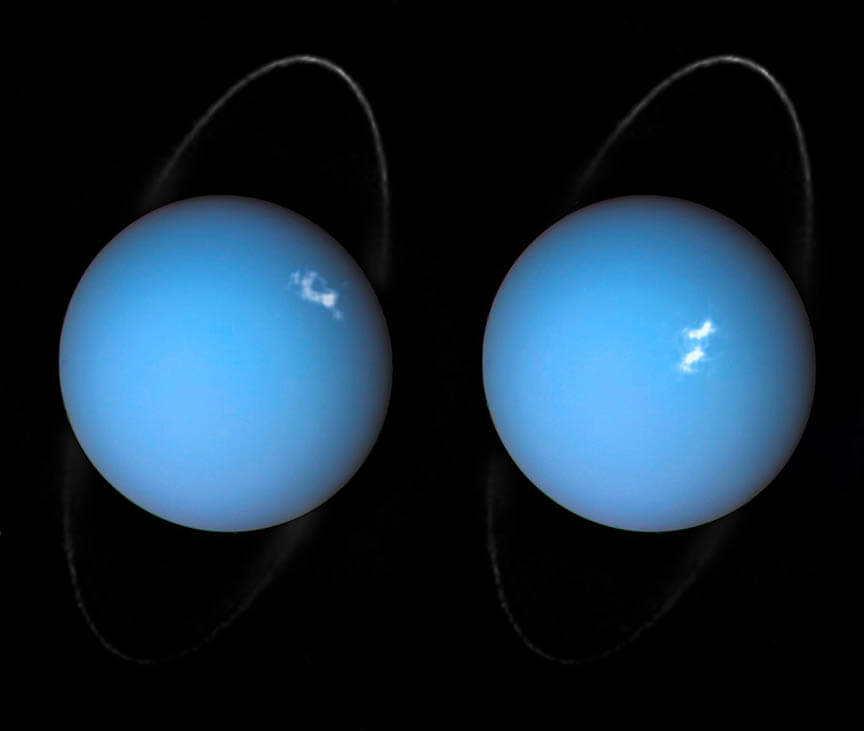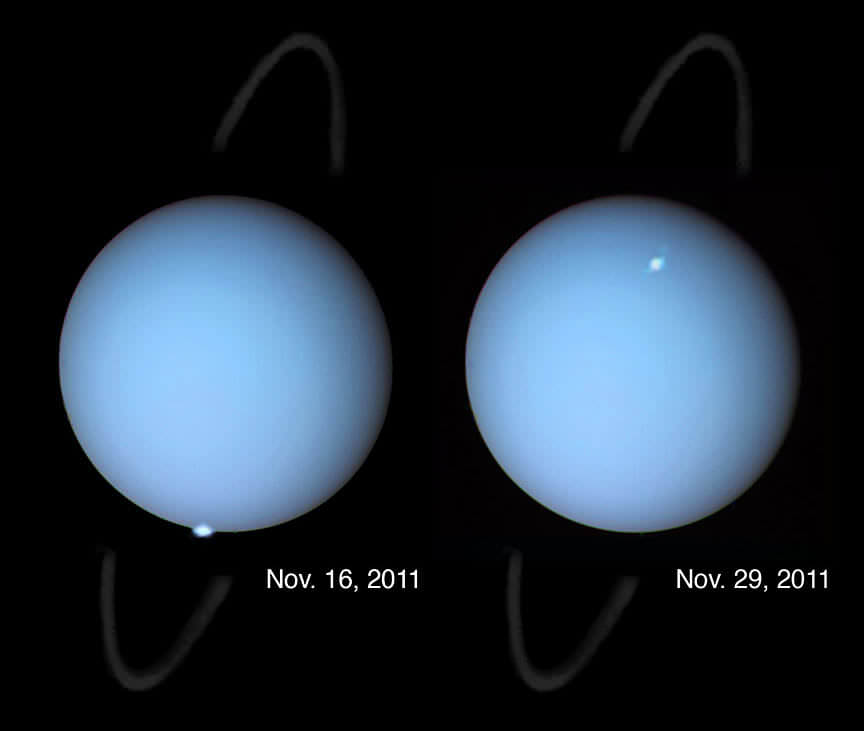
Earth doesn’t have a corner on auroras. Venus, Mars, Jupiter, Saturn, Uranus and Neptune have their own distinctive versions. Jupiter’s are massive and powerful; Martian auroras patchy and weak.
Auroras are caused by streams of charged particles like electrons that originate with solar winds and in the case of Jupiter, volcanic gases spewed by the moon Io. Whether solar particles or volcanic sulfur, the material gets caught in powerful magnetic fields surrounding a planet and channeled into the upper atmosphere. There, the particles interact with atmospheric gases such as oxygen or nitrogen and spectacular bursts of light result. With Jupiter, Saturn and Uranus excited hydrogen is responsible for the show.

Credit: NASA, ESA, and L. Lamy (Observatory of Paris, CNRS, CNES)
Auroras on Earth, Jupiter and Saturn have been well-studied but not so on the ice-giant planet Uranus. In 2011, the Hubble Space Telescope took the first-ever image of the auroras on Uranus. Then in 2012 and 2014 a team from the Paris Observatory took a second look at the auroras in ultraviolet light using the Space Telescope Imaging Spectrograph (STIS) installed on Hubble.

Two powerful bursts of solar wind traveling from the sun to Uranus stoked the most intense auroras ever observed on the planet in those years. By watching the auroras over time, the team discovered that these powerful shimmering regions rotate with the planet. They also re-discovered Uranus’ long-lost magnetic poles, which were lost shortly after their discovery by Voyager 2 in 1986 due to uncertainties in measurements and the fact that the planet’s surface is practically featureless. Imagine trying to find the north and south poles of a cue ball. Yeah, something like that.
In both photos, the auroras look like glowing dots or patchy spots. Because Uranus’ magnetic field is inclined 59° to its spin axis (remember, this is the planet that rotates on its side!) , the auroral spots appear far from the planet’s north and south geographic poles. They almost look random but of course they’re not. In 2011, the spots lie close to the planet’s north magnetic pole, and in 2012 and 2014, near the south magnetic pole — just like auroras on Earth.
An auroral display can last for hours here on the home planet, but in the case of the 2011 Uranian lights, they pulsed for just minutes before fading away.
Want to know more? Read the team’s findings in detail here.


Thot that was Neptune for a sec.
What is with all the side stepping in the acknowledgement of the cause of these findings? As proven here on earth, the Aurora are caused by BIRKELAND CURRENTS. Kristen Birkeland’s model was ridiculed for over 100 years until he was proven correct by Navy satellites in the 60’s and correctly awarded the Nobel Prize (posthumously). The flow of charged particles from the sun ( ELECTRIC CURRENT) is now established beyond all doubt.
But the dogged determination of the cosmologic mainstream to avoid clearly stating that underlying electromagnetic forces are responsible for these processes is like a white elephant in the middle of the room. The use of terms like “solar wind” for Birkeland currents and star formation occurring along “filaments” are pathetic attempts to ignore the true nature of these processes. I guess they are somehow hoping to create a role for gravity, the sacred cow of the standard model.
The sun is electromagnetically connected to all of the planets and that is why aurora are found on every planet. There is no mystery and the findings are predicted and explained by the electromagnetic models.
Nobel prizes are not awarded posthumously. Is there anything you don’t get completely wrong?
The recent NASA data is devastating the current standard model.
The findings from the IBEX mission as published in the Astrophysics Journal, October 2015, Supplement report the findings predicted by the Electric Sun model as detailed by Donald Scott. Massive “rivers of hydrogen” were confirmed to flow into the sun from extragalactic sources. The sun surface is now confirmed to be composed of plasma contained by massive magnetic fields. Scott has detailed the nature of “photospheric granules” (whatever that means) to actually be ANODE TUFTS. His superior knowledge of electrical engineering allows his interpretation of the data to be scientifically sound and meaningful.
It is becoming overwhelmingly evident that the failure of the standard model is due to to the lack of knowledge in plasma physics and electrical engineering by the astrophysicists who depended on gravity and explosions to interpret NASA data. I guess if all you have is a hammer then everything looks like a nail.